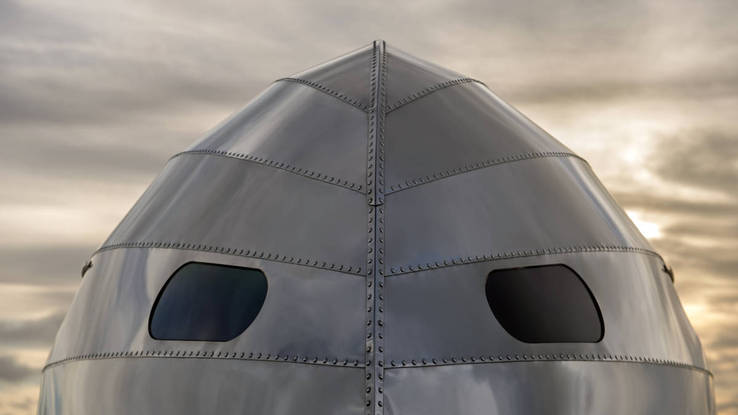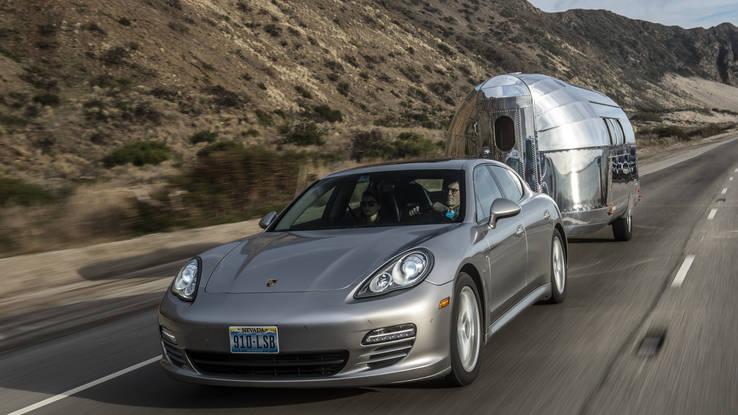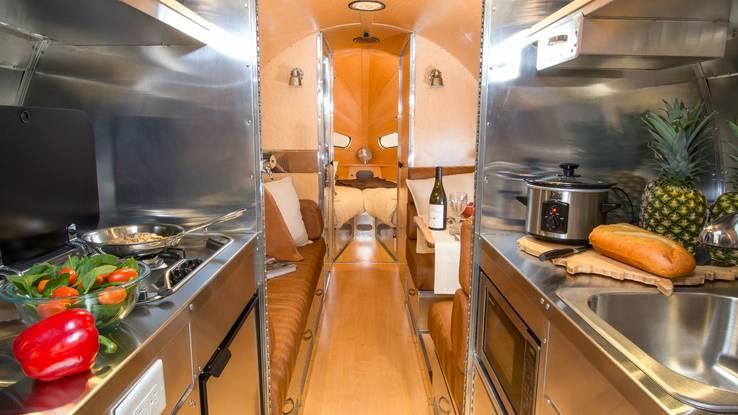Airstream’s spiritual ancestor is so light you can tow it with a plain old car (like a Porsche)
Some of those big, honking travel trailers you see on the highway — especially the big wood-and-fiberglass monsters riding on steel frames — really do need a pickup truck to get them down the road, preferably a pickup truck with the words “heavy” and “duty” in the name.
This travel trailer, the Bowlus, does not.
The Bowlus can get just about anywhere on the tow hitch of a plain old car. We know — we towed one with a Porsche, and not a Cayenne or a Macan but a very non-trucklike, 300-hp Panamera V6. Our Panamera had all-wheel drive but did not have the air suspension, which would have leveled the ride a little better. No matter: It was easy, like towing a giant hollow aluminum bullet, one with WiFi, heated floors and a king-size bed.

The rear view of the Bowlus conjures up a medieval helmet.
What is a Bowlus, you say? That’s a long story that goes back to The Great Depression and involves duraluminum, Charles Lindberg and lots of rivets. William Hawley Bowlus grew up over 100 years ago on a farm in San Fernando, California — a farm that has long since been covered over by freeway. When the Bowlus family wasn’t busy farming, the father made furniture while the son built sailplanes — beautiful aerodynamic sailplanes that looked a little like the space ships from popular fiction of the time but with long, straight wings. The single mounting point where the wings connected to the fuselage was a big, sculptural neck that looked like a piece of artwork.
Bowlus made hundreds of sailplanes and got pretty good at working with aluminum. He was eventually hired by his flying friend Claude Ryan to help build airplanes; it was Bowlus who served as factory manager during the build of a certain Ryan M-2 flown by a former Air Mail pilot named Charles Lindbergh solo across the Atlantic. Bowlus later taught Lindbergh the art of flying gliders, a pursuit Lindbergh reportedly loved.
To fly them, Bowlus had to tow his gliders to places that had wind, and sometimes had to wait at those places for days before the wind showed up. So he also built a trailer to make camping out a little easier. Being an airplane builder, he built the trailers with the same aerodynamic and structural efficiency of his sailplanes. They weighed in at just 1,100 pounds; for reference, a typical Airstream today weighs five times that much.
This was in about 1934. Despite The Great Depression, America was crazy for camping trailers, long before the term glamping was ever thought up. Bowlus built 80 riveted aluminum trailers before the bottom dropped out of the business, at least for him (a friend and former employee named Wally Byam took what he’d learned at Bowlus and started Airstream). Of those 80 original Bowlii, 40 still exist and 12 are roadworthy. The last unrestored original Bowlus Road Chief reportedly sold at auction in 2011 for $ 187,000.

At just 2300 pounds the Bowlus can be towed by a typical car with no trouble at all.
Fast-forward to modern times. Tech entrepreneurs John and Helen Long had just sold their software company and were casting about for something to do. During what the couple called “a tour of three oceans” in a Tatra (another story), Helen said to John, “Wouldn’t this be better in a trailer?”
So John found a Bowlus and, like the guy who liked the electric shaver so much, he bought the company. Or at least the rights to the name “Bowlus.” He brought in his daughter Geneva, fresh from Wharton School of Business, and they’ve been cranking out Bowlii ever since, following as closely as possible to the original Bowlus credo of light weight and aerodynamic efficiency. The new trailers are high tech, with 4G LTE, iPad streaming and heated floors.
“We’re taking what Hawley Bowlus did in the ’30s and not duplicating it, but being inspired by it,” said John.
The new Bowlus Road Chief is 8 inches wider, 4 inches higher and 13 inches longer than the original. It weights 2,300 pounds versus the original’s 1,200 pounds…plus, it’s as modern as a space station. The 2024 T3 aircraft aluminum sheets are riveted onto the 6061 square tube aluminum skeleton using a similar construction methods of the early Bowlus trailers. However, the entire skeleton frame on the 1930’s trailers were welded steel. The two layers of aluminum now sandwich polystyrene for insulation.
The new Bowlus Road Chief uses a hydronic boiler which heats standard antifreeze which is then pumped through eight separate radiators and in floor radiant heat for what Bowlus promises is “silent, comfortable and efficient heating.” The refrigerator has a “super-efficient” Danfoss compressor. The vertical structural components also serve as mounting points from which to hang kayaks or paddleboards or to tie down bikes.

Bowlus interior is snug but comfy.
“Everything serves at least two purposes,” said John. “And if it doesn’t have a double use we say, ‘How can we lighten it?”
So it’s not some wood-frame road wheezer rattling down the highway behind your typical particulate-belching truck. Even some trailers that you would think would be pretty light –- Airstream is the obvious competitor –- can tip the truck scales at over 5,000 pounds, compared to the thin, relatively low-slung Bowlus at just 2,400 pounds. The first Bowlus trailer was pulled by a Model T, fer cryin’ out loud.
This Bowlus Road Chief is 24 feet long, just under 8 feet high and 6 feet, 8 inches wide. That’s a foot-and-a-half narrower than your typical Airstream and 4 inches lower. Its toaster-like proportions are both good and bad. Good because, as we said, it’s light and offers less aerodynamic drag, but bad in that there’s not as much room inside as a comparable Airstream. While headroom in a Bowlus is a hearty 6 feet, 4 inches, the narrower width means you can’t do ballet inside or, more likely, yoga — at least not as much as you can in an Airstream.
We spent a weekend glamping in a 28-foot Airstream Eddie Bauer Edition a few years ago and really enjoyed the extra room. There was space for many people to stretch out. The Bowlus is more “comfy snug,” which might be perfect for a traveling couple or a young family, and allows you the greater enjoyment of towing with a sedan instead of a bouncy truck. Though, as we said, a sedan with airbag suspension might be your best bet. The Bowlus puts only 175 pounds on the trailer hitch, too, meaning a skinny person can pull and wheel it around once detached. We did it, so can you.
Is there any drawback to the beauteous Bowlus?
Yes, there is cost: $ 115,000 gets you the Heritage Edition, which officially sleeps only three, does not have the heated floor and makes do with canvas instead of the luxury of faux-leather seating surfaces. The Open Road Edition sleeps four, starts at $ 137,000, and you’ll add three grand to convert that forward berth to a king size bed. By comparison, the cheapest Airstream, the 16- to 22-foot Sport, starts at about $ 44,000. Prices of Airstreams go well over 100 grand but most models are less than that.
At the other extreme you could buy a perfectly serviceable used fiberglass trailer on eBay for $ 6,000. But you wouldn’t wow the crowds at the KOA dump station and it might tug your truck around a little in a crosswind.
Compared to the price of a Swan 75 or a vacation condo, the Bowlus isn’t outrageous. In fact, for the freedom of the open road in an efficient road tube of happiness, that’s nothin’.

























